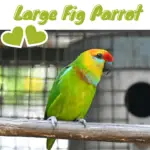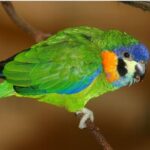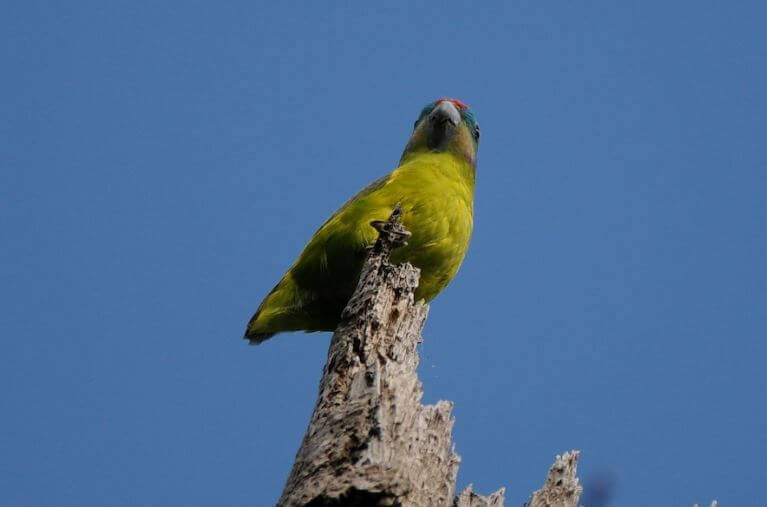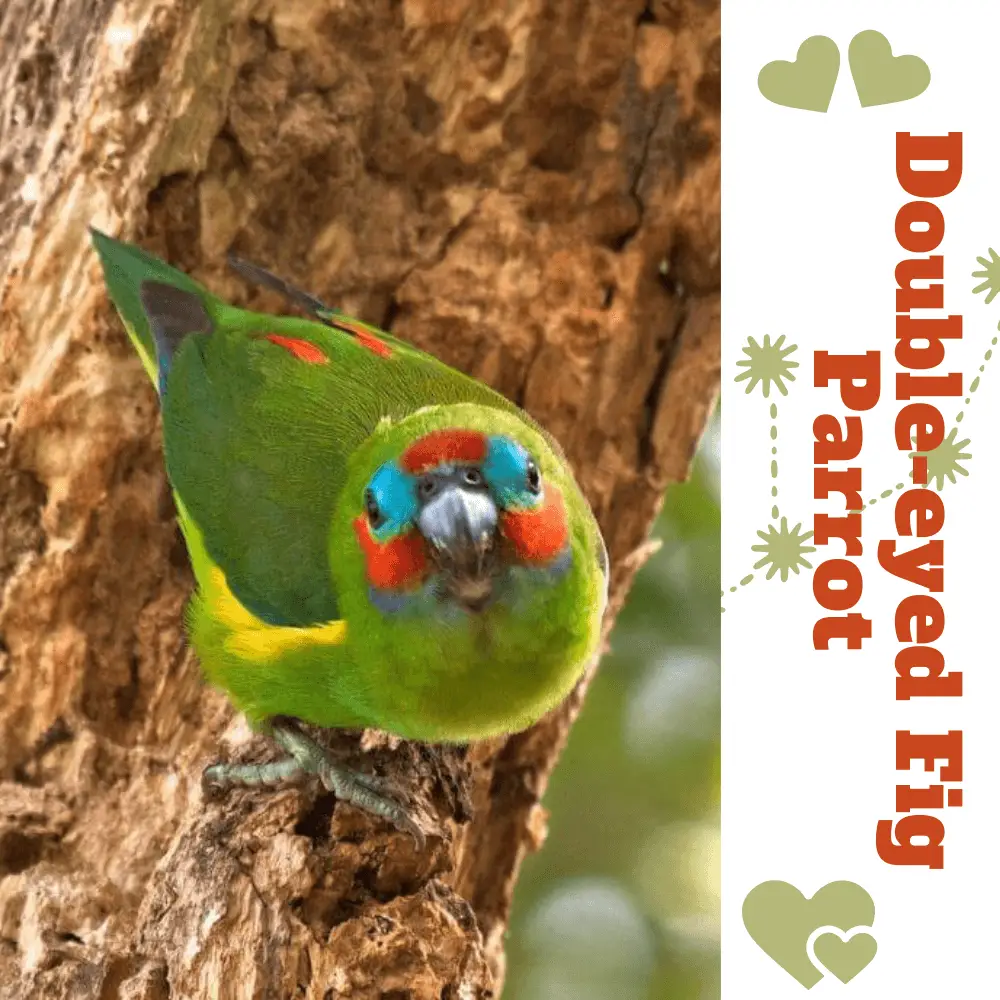
Double-eyed Fig Parrot (Double-eyed)13–16 cm; 25–56 g; wingspan 25–28 cm. Green above, yellowish-green below; crown red shading to orange then green on the hind crown; area in front of eye pale blue shading above it to green;
the area from the base of the bill and chin back to ear-coverts red, bordered dark blue on lower ear-coverts; sides of breast and flanks yellow; some red on the inner part of wing; flight-feathers dark bluish, with the yellowish-white band on the underside of secondaries.
Female has lower cheeks buffy-pink. Immature like a female; a young male acquires adult plumage at the age of 14 months.
Race coccineifrons darker, with the broader yellow-orange band on the crown; aruensis with blue on ear-coverts to the chin, greenish tinge to blue in front of the eye, little or no orange on the crown and yellower-green upperparts, while the female has no red on face, with turquoise-blue crown,
lores and upper ear-coverts, mauve-blue throat-sides and pale greyish-buff cheeks; virago little (almost no) blue on the face, with paler upperparts than nominate, male has paler red on the head than aruensis,
while the female has a red spot on the forecrown, mainly green face, with a blue tint to the crown and no blue on ear-coverts; inseparable has no blue or buff on cheeks, yellower-green underparts, red spot on forecrown (bordered blue at rear) and sexes are basically alike;
marshall is very similar to aruensis but lacks a green tinge, the male has deeper blue in front of the eye, paler red face, darker blue primaries, and the yellow crown band is more prominent; and macleayana lacks red on lores, crown green,
with a bold scarlet band across cheeks and ear-coverts (in the male), bright turquoise lores and bright turquoise-green below the eye, green stripe above and behind the eye, mauve band below ear-coverts, and female has buff cheeks with turquoise-blue markings.
Double-eyed Fig-Parrot (Coxen’s)
c. 15 cm. The smallest Australian parrot, other than marginally larger em>C. diophthalma. Fairly small, plump-bodied, and short-tailed; largely bright green, with blue forehead, red band on ear-coverts, cheeks to lores flecked yellow, and a violet-blue band across the lower face; bright violet-blue outer wing.
Sexes are similar, but orange-red is virtually absent on lores of females. Immature is basically like a female; a young male acquires adult plumage in 14 months. Compared to formerly conspecific (but allopatric) C. diophthalma, but larger and male letters lack a blue forehead, whereas a female lacks a bold red lower face.
Editor’s Note: This article requires further editing work to merge existing content into the appropriate Subspecies sections. Please bear with us while this update takes place.
Blue-faced fig parrot (Double-eyed)
Hitherto included C. coxeni as subspecies (see that species). Seven subspecies were recognized.
Blue-faced fig parrot (Coxen’s)
Hitherto treated as conspecific with C. ophthalmia, but differs in a male being only formed with blue (not red) on the forehead; female being only form with bold red lower face; larger size (at least 1).
Subspecies
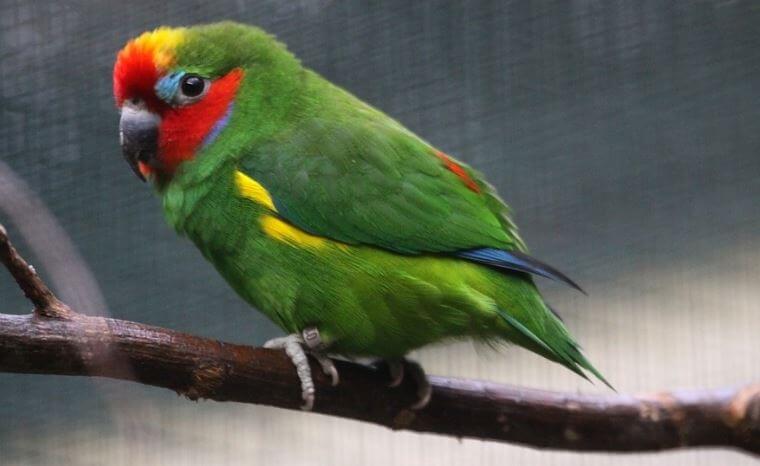
Blue-faced fig parrot(Double-eyed)Cyclopsitta diophthalma [diophthalma Group]
Cyclopsitta diophthalma diophthalma Scientific name definitions
Distribution
Cyclopsitta diophthalma aruensis Scientific name definitions
Distribution
Cyclopsitta diophthalma coccineifrons Scientific name definitions
Distribution
Cyclopsitta diophthalma virago Scientific name definitions
Distribution
Cyclopsitta diophthalma inseparabilis Scientific name definitions
Distribution
Cyclopsitta diophthalma marshalli Scientific name definitions
Distribution
Cyclopsitta diophthalma macleayana Scientific name definitions
Distribution
Blue-faced fig parrot (Coxen’s)Cyclopsitta diophthalma coxeni Scientific name definitions
Distribution
Distribution
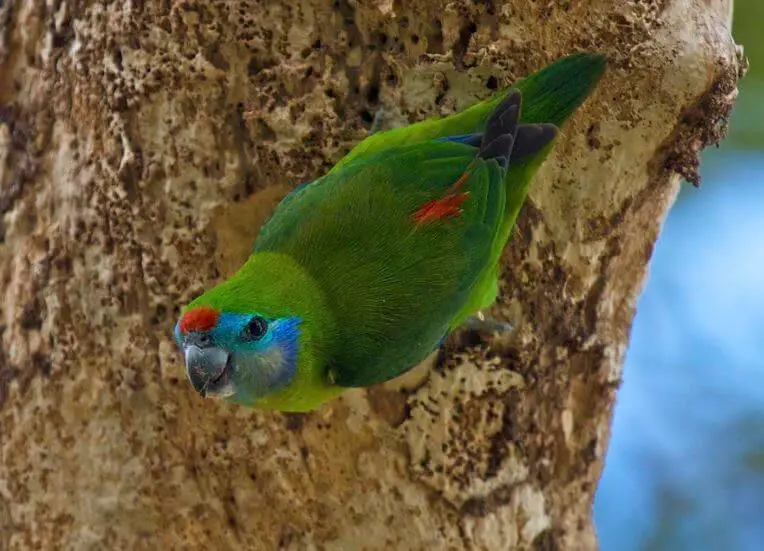
Blue-faced fig parrot(Coxen’s)
SE Queensland and NE New South Wales, in coastal E Australia.
Habitat
Double-eyed Fig-Parrot (Double-eyed)
Lowland and montane forest and edge, riverine and more open woodland, tall second growth, partly cleared areas with clumps of trees, mangroves, sometimes entering parks and gardens, scrub, cultivated areas, and mangroves, especially in Australia. Generally up to 1600 m, occasionally as high as 2000 m.
Double-eyed Fig-Parrot (Coxen’s)
Small patches of subtropical rainforest or edges of larger areas and often at the ecotone between rainforest and sclerophyll assemblages, especially areas with large Ficus trees. Was formerly probably concentrated in the alluvial forest.
Migration Overview
Double-eyed Fig-Parrot (Double-eyed)
Apparently nomadic at least in parts of NE Australia, but the reason for nomadism is apparently unexplained.
Diet and Foraging
Double-eyed Fig-Parrot (Double-eyed)
Fruits, particularly figs such as Ficus eugenioides, F. copiosa, F. destruans, F. drupaceous, F. hispida, F. ehretii, F. macrophylla, F. benjamina, F. opposita, F. pleurocarpa, F. racemosa, F. variegata and F. watkinsiana (seeds rather than flesh being taken),
but also e.g. Croton, Elaeocarpus grandis, Trema orientalis, Alphitonia whitei, Glochidion sumatranum, berries, seeds, nectar (e.g. Grevillea robusta), bark or fungal growths, and insects (e.g. Coleoptera and Diptera).
Feeds at all levels in vegetation, often with fruit-doves, figbirds (Sphecotheres), and other parrots, including Trichglossus chlorolepidotus, Glossopsitta pusilla, G. concinna, and Platycercus elegans.
Double-eyed Fig-Parrot (Coxen’s)
Diet is largely comprised of figs, with seeds being preferred to fruit, but no detailed studies. Usually encountered in pairs or small groups.
SOURCE: Tim Siggs
Sounds and Vocal Behavior
Double-eyed Fig-Parrot (Double-eyed)
Gives a thin, high-pitched “seet-seet” frequently in flight, including immediately before take-off and on alighting; also a chattering twitter, and a high-pitched rolling screech (in alarm or when going to roost),
sometimes another member of the pair gives “chink” note in response; compared to Glossopsitta pusilla, while food-begging young give “ju ju ju ju ju” calls.
Flight call is more disyllabic, staccato, and harsh, being somewhat reminiscent of Melopsittacus undulatus, while larger fig-parrots (e.g. in New Guinea) have stronger calls or higher pitched in case of C. gulielmitertii superspecies. Tends to be mainly silent while feeding.
Breeding
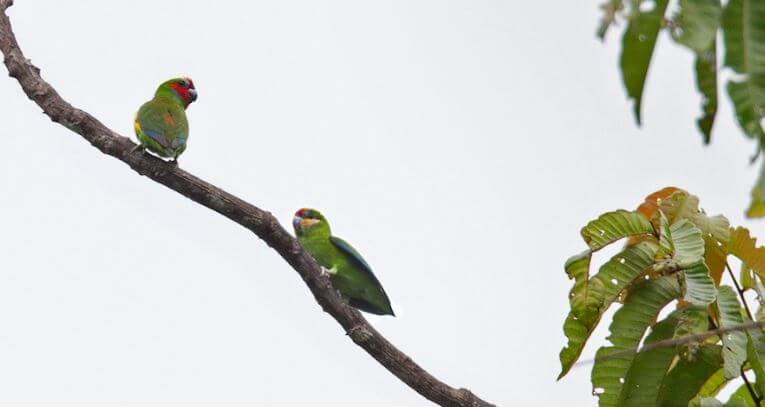
Double-eyed Fig-Parrot (Double-eyed)
Variably recorded: Mar-May in New Guinea, but extending, e.g. breeding-condition female at the hole in Jun, or recurring later, e.g. Nov (adults at nest with young);
Aug–Dec (laying mainly Aug and Sept) in Australia, although nest excavation can occur as early as May (race marshalli) or Jul (macleayana) and chicks have been reported fledging as early as Oct. Monogamous.
Nest in hollow of high (once c. 25 m) often an emergent tree, or in rotten tree-trunk or dead limb, e.g. (in Australia), Cocos nucifera, Lophostemon suaveolens, Ficus, Alstonia, Alphitonia, Castanospermum
Australe, Pandanus sp., Mangifera indica, Melaleuca, and Eucalyptus, excavated by the female alone (guarded by a male), using soft wood chips as lining, and accepts nest boxes in captivity. Perhaps double-brooded, at least in captivity.
Eggs 2–3 (probably usually two), white, size (marshalli) 21·6 × 17·5 or (macleayana) 20·6–21·8 × 17·3-18 (captivity), mass c. 4–5 g, laid at 1–2-day intervals;
incubation period 18–24 days, starting with the first egg, by female alone; young weigh c. 3–4 on hatching, nestling period 36–52 days or more, mass at fledging c. 36–42 g, fed by male-only from day 29 (in Australia), and independent only 7–10 days after fledging.
Double-eyed Fig-Parrot (Coxen’s)
Season, probably Oct–Jan, with laying in Oct. Breeds in excavated hollows in living or dead trees; nest and eggs undescribed, but unconfirmed reports suggest that they are similar to those of C. diophthalma.
Conservation Status
Double-eyed Fig-Parrot (Double-eyed)
Not globally threatened. CITES II. Locally common, especially in lower reaches of the altitudinal range, being mainly replaced at higher levels in New Guinea by the C. gulielmitertii superspecies; general sense of rarity, e.g. in Vogelkop and many parts of S New Guinea, probably related to the difficulty of detection.
Total population estimated, in the late 1990s, at in excess of 100,000 individuals, when considered to be stable; however, race macleayana (of NE Queensland, Australia) perhaps numbers no more than 5000 birds and has been speculated to be declining,
although it is known to breed in parks and gardens within the city of Cairns, and is generally common within its comparatively small range. The other Australian subspecies, marshalli, is also common.
Double-eyed Fig-Parrot (Coxen’s)
ENDANGERED. CITES I. Population most recently estimated at just 50–250 mature individuals, and considered stable. Recorded at scattered sites from Bundaberg south to Hastings R and inland to the Bunya Mts and Main and Koreelah Ranges, but considered to be highly fragmented following declines since 1950 due to habitat loss;
four subpopulations are thought to remain, in the greater Bundaberg region, Maleny/Imbil/Kin Kin Creek area, the Queensland/New South Wales border area (Lamington National Park, Whian Whian State Forest, Alstonville plateau), and the upper Hastings R catchment, with no more than 50 individuals in each.
Widespread clearance of lowland rainforest has meant only small fragments of former habitat remain and are vulnerable to the spread of invasive weeds, while isolated stands of fig trees (probably an important source of food in winter) may be lost due to a lack of natural recruitment.
Probably associated impacts from fragmentation, poor quality and a small area of remaining habitat, and small population size, with lack of connections between habitat patches a possible barrier to dispersal, making it difficult for birds to find sufficient food, especially in winter, the may have increased degree of competition between it and other species of birds.
Known from 16 conservation units; in Queensland, Bunya Mountains National Park, Burrum Coast National Park, Conondale National Park, Deepwater National Park, Great Sandy National Park, Lamington National Park, Main Range National Park, Mapleton Falls National Park, and Mount Pinbarren National Park; and in New South Wales,
in Border Ranges National Park, Nightcap National Park, Richmond Range National Park, Tooloom National Park, Toonumbar National Park, Boatharbour Nature Reserve, and Booyong Nature Reserve.

